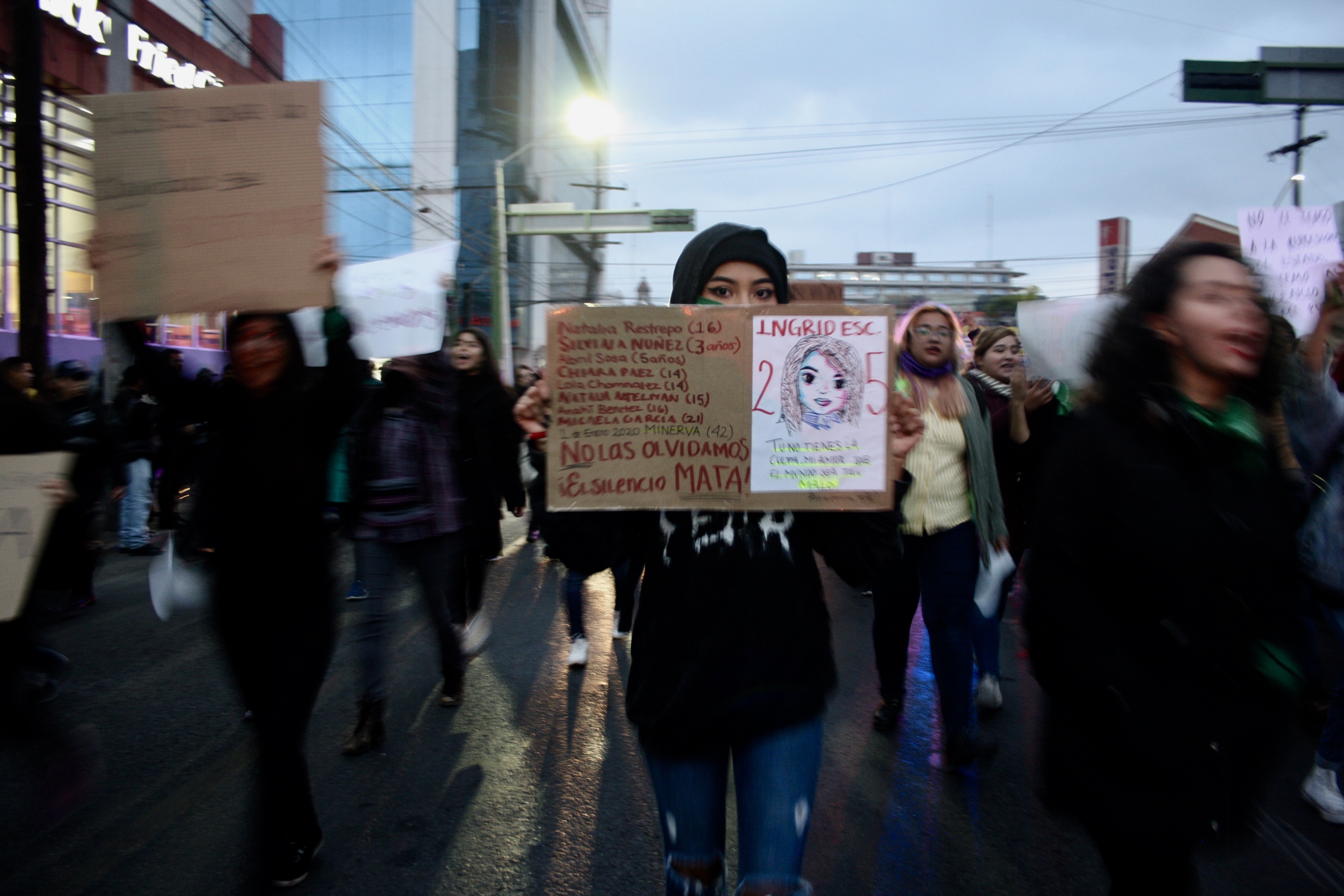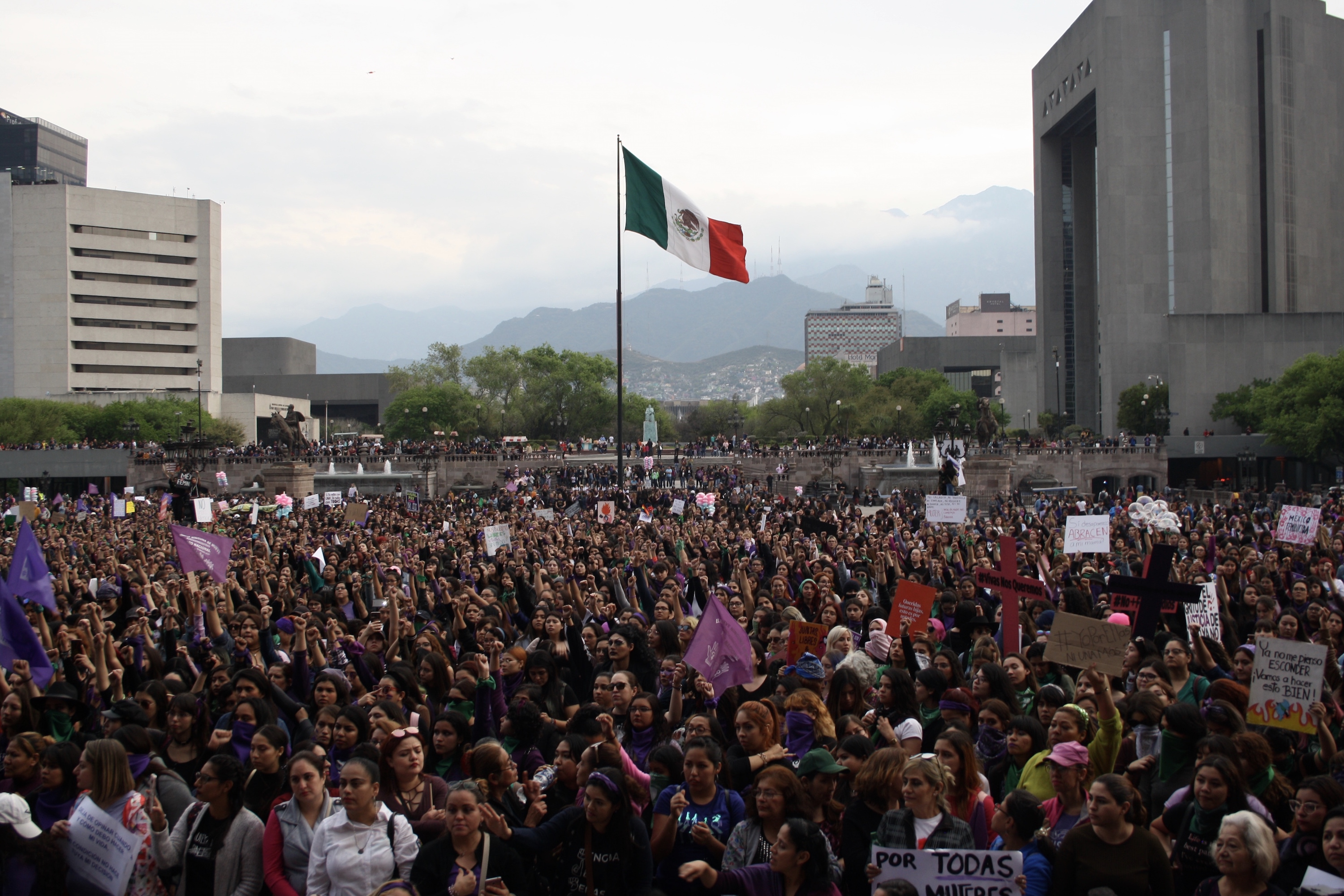In Mexico’s state of Nuevo León, a new sororidad rises

Monterrey, Mexico — On February 21, 2020, more than 400 women stood silently in front of the Government Palace of Nuevo León in the Mexican city of Monterrey. They were dressed in black with purple and green handkerchiefs tied to their necks, holding up homemade signs denouncing femicidal violence that kills 10 women every day in Mexico. Their jaws were clenched tight with endless rage. Their gazes reflected that which is born when a sense of hopelessness converges with sorority. They those gazes for over three hours.
Later, a group of women between 19 and 24 years old came before the crowd and took turns sharing their own stories of sexual harassment and violence. “I do believe you,” the crowd chanted after each woman’s testimony. Surrounded by dozens of police officers, the women filled the Esplanade of Heroes in front of the palace to secure a safe space for them to grieve the collective sexualized violence against women.
Days before, a modified version of the viral “Femme Fist” print with the hashtag #YoPorEllas circulated through social media and WhatsApp groups. It gave a time, a date, and a place. But no feminist collective or women’s association was mentioned. It was a leaderless protest.
These days, women, especially young women, are a more common sight in public spaces in the northeastern state of Nuevo León, just across the U.S.-Mexico border from Texas. Even though they’re in constant danger of being harassed, attacked, murdered and disappeared, they show up not only to denounce gender-based violence but to find one another, forge relationships, and create new forms of organizing and activism.
Protests against gender-based violence are regular occurrences in the country’s capital, Mexico City, but now, they’re also increasingly more present in Monterrey, the industrial capital of Nuevo León known for its deep conservatism and dominant business culture. The protest on February 21 signaled the re-emergence of feminist organizing and mobilizing in one of Mexico’s most conservative states.

In the late 1990s and early 2000s, feminist organizations in the state were created to address diverse gender issues like female labor, political participation, reproductive and sexual health, and domestic violence.
Through citizen participation, previous generations promoted a thoughtful and combative civil society committed to developing gender equality in democracy building, against a political background in which the ruling party had been in power for more than 70 years. From the early 2000s, when the conservative National Action Party — whose strength was in the northern part of the country — defeated the long-lasting Institutional Revolutionary Party, their struggle focused on resisting conservatism in every social and political sphere.
But their numbers remained small, and their demands could never fully widen the public debate.
Now, young women and girls have taken up the mantle of the country’s feminist movement. Instead of lobbying from within the system like the generation before them, these young feminists are creating their own free and safe spaces to share, bond, and mobilize: online, they share their experiences of violence and organize into collectives, creating agendas that incorporate all those experiences; offline, they protest and pursue concrete actions to expose and dismantle the violence.
“[Demonstrations] always had the same people, [mostly] women in their late 20s, early 30s,” explained 18-year-old Frida, who’s been joining the protests in Monterrey for the past two years. “[They] weren’t bad, but more people were needed. The February 21 one, that was a very spontaneous protest — there were too many people. It was surprising, and almost all were from my generation.”
This new sororidad is no longer interested in securing a stronger role for women in Mexican society; it’s gunning for a louder, more radical feminism, pulling up the roots of the old system — which it claims innately dehumanizes women — as it nurtures a new one.
Its first demand is radical enough: “Stop killing us.”

Brutal slayings awaken a call to arms
In early February of this year, 25-year-old Ingrid Escamilla of Mexico City was brutally murdered by her partner, and her body was found skinned. Forensic photographs of her mutilated corpse were then leaked, apparently by city police officers, and published on nota roja newspapers (“bloody tabloids”). Women across the nation responded by filling social media with pictures of beautiful landscapes and nature scenes, accompanied by the hashtag #IngridEscamilla, to bury the horrific pictures. Then, they mobilized.
Early Valentine’s Day morning, protesters in Mexico City sprayed blood-red paint and graffiti on the National Palace and interrupted President Andres Manuel López Obrador’s daily morning press conference to demand an end to gender-based violence.
In solidarity with the actions taking place in Mexico City, around 100 women marched through the streets in downtown Monterrey that same day, brandishing signs with the slogans “Justicia para Ingrid” (Justice for Ingrid) and “Justicia para Todas” (Justice for All). They braved the evening cold, pumping their fists in the air as they chanted “México feminicida” (Mexico murders women) and “¡No estás sola!” (You’re not alone!).
That following weekend, a week after Escamillas’ murder, the body of seven-year-old Fatima Aldrighetti, who was abducted at her school, was found in a plastic bag, showing signs of abuse and torture. Security footage showed Aldrighetti leaving the school with a woman, apparently known to the family, a mere 15 to 20 minutes before her mother, who was late picking her up that day, arrived at the school.
The president blamed neoliberal policiesfor the surge in femicides and described the feminist protests as a conservative plot against his government to distract attention from his social programs. “I don't want the issue just to be women’s killings,” he said.
Both murders, along with the government’s continued reluctance and evasiveness to address the roots of this structural violence, unleashed a series of protests across the country. Even women who either viewed the violence as isolated or viewed protest activism as violent, or both, took to the streets with their rage.
In Monterrey, many young women began protesting for the first time.
“It’s terrible what’s happening. Instead of seeing funny things on my Facebook, I see missing and murdered women every morning,” said 21-year-old Jeydi, who joined the February 21 demonstration — her first ever protest. “It was like suddenly waking up to reality. There is more talk and it’s [the violence] becoming more evident.”
Between January and February, the country’s National System of Public Security registered 630 homicides of women, but only 164 cases were classified as femicide, the gender-based murder of a woman or girl, particularly by a man. Nuevo León currently ranks fourth among the states with the most femicides after 15 women were killed in the first two months of this year. Nuevo León Women’s Institute and the state’s special prosecutor for femicides and crimes against women did not respond to our request for comment on its handling of femicide cases.
“I am here for what we live in our social circles. From our personal experiences to what we face even at work,” said 27-year-old Susan, who also attended the protest at the government palace and makes a point to participate in protests in the city whenever they occur. “We have to keep doing it until more people join us and we manage to remove the stigma from the word ‘feminist.’”
“It’s not only about organizing,” said Frida, who is also vice president of the feminist student group “Mujeres con Alas” at the private Universidad de Monterrey. “It’s a circle of dialogue, mutual support, and trust. It’s an exchange of knowledge in a free space we’ve created.”

A rising tide of feminist action
On 8 de Marzo (International Women’s Day) this year, Nuevo León saw its largest feminist demonstration to date. The state’s civil protection agency put the number around 15,000 people, but Asamblea Feminista — an organization in Nuevo León that brings together feminist causes to empower and promote aid among women and the main event organizer — estimated almost 30,000 participants, compared to last year’s figure of approximately 5,000.
Banners reading “We are the cry of those who are no longer here” and “They took so much from us that they ended up taking away our fear” in bold letters were seen as women marched through Monterrey’s downtown.
“Changes have been forging over the years,” said a spokesperson for Asamblea Feminista. “Slow, but [we’re] building and including more and more women. We were able to convene women with disabilities, and young women from middle and high school also joined.”
On March 9, the protest continued with “Un Día sin Nosotras” (A Day without Us). The national strike was organized to acknowledge the thousands of women who had been disappeared, and to generate a dialogue across generations and socioeconomic barriers to address the structural violence Mexico’s women face. It called on women and girls to stay home, skipping school and work, and to not buy any nonessential goods. Women who couldn’t afford to miss work were invited to show their support in other ways, such as by wearing something purple, the color of feminist resistance against all forms of violence.
In Nuevo León, people were more inclined to strike than to march, since the public is still generally uncomfortable with social protest and its potential for violence. Likewise, the demand for the right to legal, safe and free abortion, as well as the social stigma of feminist activism, continues to dissuade some women from joining the movement.
Although not all women supported the strike, the action pushed the conversation beyond feminist collectives and “radical” women into the national discourse.
“Having seen an 8 de Marzo that was crowded and a Día Sin Nosotras so impressive has given us a lot of courage and the strength to do things that have not been done before,” said a spokesperson for Mujeres + Mujeres, a collective promoting a gender perspective in media and another organizer of the events. “Much of what was accomplished was realizing that we are not alone, not even in the north.”
More articles by Category: Feminism, Gender-based violence, International, Violence against women
More articles by Tag: Mexico, Femicide



























